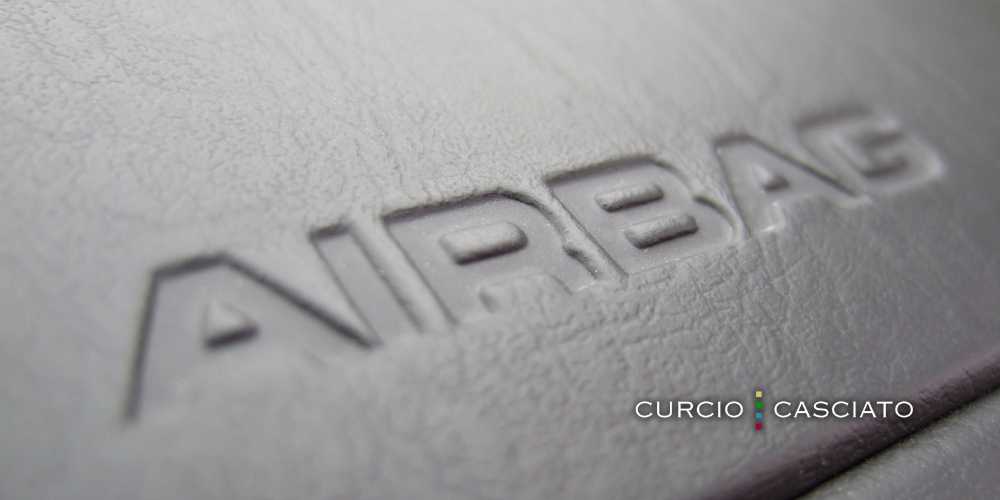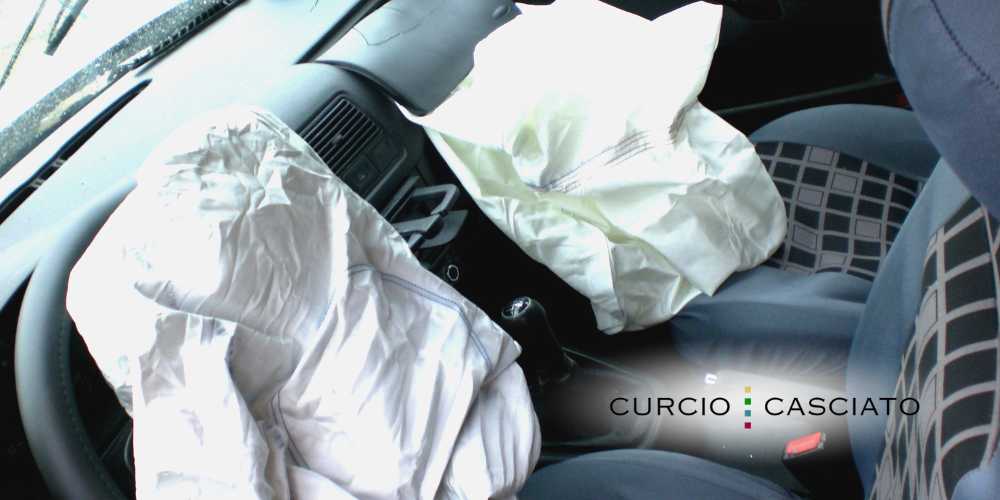Chicago Defective Airbag Lawyer
PRACTICE AREAS
The Chicago defective airbag lawyers at Curcio & Casciato fight for vehicle occupants who suffer serious but common airbag injuries due to airbag defects in car accidents. Faulty airbags can fail to deploy, deploy too forcefully, or send dangerous metal fragments flying, resulting in common injuries such as burns, facial injuries, traumatic brain injuries, neck injuries, chest trauma, or even death. The Takata airbag recall is one of the largest in history. Widespread serious injuries and countless lives have been lost due to faulty airbags that explode upon impact. Defective airbags often don’t prevent drivers from hitting the steering wheel in car accidents, increasing the severity of collision outcomes. When manufacturers fail to provide safe equipment, our Chicago airbag injury lawyers offer skilled legal assistance so that clients can cover the cost of their economic damages. If you’ve been injured because of airbag deployment or safety issues, contact a skilled Chicago airbag failure lawyer.
Call (312) 321-1111 for a free initial consultation.

Common Causes of Airbag Injuries in Chicago, IL
Malfunctioning airbags can lead to serious injuries, even when seat belts are used. Tens of millions of motor vehicles rely on these safety features, yet vehicle occupants sometimes life-changing injuries or wrongful death in car accidents when these systems fail to operate as intended. When airbags don’t deploy properly, an injury lawyer in Chicago, IL, can negotiate with the insurance company to ensure clients recover financially and receive adequate settlement offers.
Our Chicago airbag failure lawyers handle car accident cases involving the following common injuries:
Defective Airbags
Airbag defects can put vehicle occupants at serious risk. Several factors contribute to defective airbags, including safety equipment that deploys late, or at the wrong time, such as when a motorist hits a pothole, for example. If you’ve been injured, contact a Chicago defective airbag lawyer from our legal team.
Airbag Failed
An airbag malfunction, rendering failure to deploy, can leave drivers and passengers unprotected from the steering wheel or dashboard in an accident, often causing serious damage. If the vehicle’s airbags fail to deploy, the safety feature meant to absorb the crash’s impact does nothing, increasing the risk of severe harm. A Chicago airbag failure lawyer can ensure negligent manufacturers are held liable through product liability lawsuits and secure maximum settlements on behalf of clients.
Multiple Airbag Deployments
Multiple airbag deployments occur when an airbag quickly deploys more than once during an accident, causing serious but common injuries for vehicle occupants. Malfunctioning electrical components or product sensors can cause multiple airbag deployments, increasing the risk of harm. If you’ve suffered personal injuries due to multiple deployments in an accident, a Chicago defective airbag lawyer from our legal team can file a product liability lawsuit and ensure the responsible manufacturer is held liable.
Airbag Deployed With Too Much Pressure
When a frontal airbag deploys with too much force, it can result in critical personal injuries. Drivers and passengers may suffer broken bones, traumatic brain injuries, internal bleeding, and facial injuries due to the extreme impact of a crash. In some accident cases, defective airbags explode violently, posing an even greater risk of harm. If you or a loved one sustained critical injuries caused by a frontal airbag defect, our Chicago defective airbag lawyer will provide skilled legal representation to help clients secure financial compensation from the responsible manufacturer.
Most Common Airbag Injuries in Chicago
Common issues that large corporations ignore when developing, installing, or replacing can trigger catastrophic airbag injuries during a car accident. Our Chicago airbag injury attorney teams offer skilled legal representation to vehicle occupants and injured parties by negotiating with insurance companies. If you’ve sustained injuries or lost a loved one to wrongful death in a collision, call a defective airbag lawyer in Chicago, IL for a free initial consultation.
The most common airbag injuries include:
- Head Injuries and Traumatic Brain Injuries – Caused by extreme force deployed on drivers and passengers.
- Facial Injuries and Eye Injuries – Severe damage due to impact with the stiffness of the steering wheel or dashboard.
- Neck Injuries & Spine Damage – Whiplash and nerve damage from improper airbag deployment
- Rib Fractures & Upper Body Injuries – Pressure from the car’s airbags can break bones and cause multiple fractures.

Can Airbags Kill You?
While airbags are designed to protect drivers and passengers, there are instances when the safety feature itself can contribute to fatal injuries. In rare cases, airbag malfunctions or problems with the safety components have been linked to fatal injuries. When consumers are hurt because companies produce products that don’t deploy properly, the result can be severe injuries that escalate to wrongful death cases.
If you need legal assistance filing a wrongful death suit, schedule a free and confidential consultation with our Chicago fatal car wreck lawyers.
Open Airbag Recalls
Malfunctioning airbags have led to numerous recalls in recent years, as airbag defects in car accidents can seriously hurt vehicle occupants. These issues include airbags that fail to deploy, deploy with too much force, or explode during collisions. To prevent this, motorists should check their VIN on the manufacturer’s website or the NHTSA database to see if their car has been recently added. Taking this step can avoid potential dangers. If you have been injured due to a defective airbag, a Chicago airbag injury attorney can assist in pursuing compensation for your injuries suffered.
Takata Airbag Recall
The Takata airbag recall remains the largest and most complex auto problem in U.S. history. Approximately 67 million Takata airbags have been recalled due to airbag defects that can cause the inflators to explode upon deployment, releasing sharp metal fragments. Vehicles involved in the Takata airbag recall have been linked to at least 28 and potentially countless lives since 2009.
Automakers that use these Takata products include Acura, Audi, BMW, Cadillac, Chevrolet, Chrysler, Dodge, Ferrari, Ford, GMC, Honda, Infiniti, Jaguar, Jeep, Land Rover, Lexus, Mazda, McLaren, Mercedes-Benz, Mitsubishi, Nissan, Pontiac, Saab, Subaru, Tesla, Toyota, and Volkswagen. Vehicle owners are urged to check their Vehicle Identification Number (VIN) to determine if their car is affected. Contact a Chicago Takata airbag lawyer to learn more.
Volkswagen Airbag Recall
Volkswagen has recalled 114,478 vehicles, including certain Beetle and Passat models from 2006 to 2019, due to an airbag defect on the driver’s side. This stems from the breakdown of chemicals in the inflators after prolonged exposure to extreme temperatures, which could lead to spontaneous explosions and potentially serious injuries or fatalities. Affected vehicle owners should contact their dealerships for replacements. To understand your legal rights, call a Chicago Volkswagen airbag lawyer from our law firm.
Kia Airbag Recall
Kia America, Inc. has recently issued a recall for over 80,000 electric and hybrid vehicles, specifically targeting the 2023-2025 Kia Niro EV, Niro Hybrid, and Niro Plug-in Hybrid models. The Kia airbag recall addresses improper floor wiring that could interfere with airbag deployment, potentially causing unintended side curtain airbag deployment. A Kia airbag lawyer can assist in recovering financially.
BMW Airbag Recall
BMW has recently published a recall affecting millions of vehicles due to potential defects in parts supplied by Takata. The recall includes models produced between 2003 and 2017, with a substantial number of affected vehicles. The faulty airbags may rupture, releasing metal fragments that could cause severe injuries. Call our Chicago BMW lawyers to explore your legal options.
Liability in Illinois Airbag Injury Cases
In Illinois, liability in airbag injury cases arises when motor vehicles equipped with defective or malfunctioning airbags don’t protect vehicle occupants during an accident, even when seat belts are used. In such cases, a Chicago airbag injury lawyer is crucial for victims needing to recover. Call our legal team for a free consultation.
- Vehicle Manufacturers – Vehicle manufacturers must provide safety features that deploy correctly. When defective airbags cause injuries, they fail to protect drivers and passengers, making them liable for compensation for common airbag injuries, including head injuries, rib fractures, spinal injuries, and even death.
- Airbag Manufacturers – Airbag manufacturers are responsible for ensuring airbags deploy correctly to protect vehicle occupants. When faulty airbags cause injuries, such as facial or eye injuries, the injured party can pursue a suit against the manufacturer, and a Chicago defective airbag lawyer can work diligently to make sure they’re held liable
- Mechanics and Repair Shops – When airbags aren’t properly installed or replaced, those responsible can be liable for injuries after a car accident. If a used vehicle’s airbag system isn’t installed correctly, defective airbags may lead to further harm, making the repair service liable for these injuries.
- Insurance Companies – Insurance companies often contest claims when defective airbags cause injuries, making it harder to obtain fair settlements for both common and severe cases. An injury lawyer can help secure the compensation you deserve when insurers try to minimize payouts.
If you’ve sustained injuries in a crash, schedule a free consultation with our Chicago defective airbag lawyers.

How To File a Personal Injury Claim for an Airbag Injury in Chicago
Filing a personal injury claim for an airbag injury starts with obtaining medical attention after a car accident. A medical evaluation is critical to document the victim’s injuries, such as head injuries, spinal injuries, or facial injuries.
Next, it is important to gather records, including information about any airbag recall and the vehicle identification number, to support the claim. A Chicago airbag injury lawyer can help guide clients from start to finish, making it easier for vehicle occupants to seek compensation.
How an Airbag Injury or Airbag Failure Lawyer in Chicago Can Help
A lawyer specializing in airbag injury or failure cases can simplify the claims process and work to secure financial compensation when defective or malfunctioning airbags cause injuries. Legal assistance may include:
- Reviewing medical evaluations and injury documentation
- Assessing insurance company offers to ensure fair settlements
- Gathering evidence of airbag defects and malfunctioning safety features
- Pursuing claims for damages ranging from common airbag injuries to severe cases like traumatic brain injuries, rib fractures, or wrongful death
Call a skilled airbag injury attorney in Chicago at 312-321-1111 for a free initial consultation if a car accident involving an airbag malfunction has left you or a loved one injured.

Chicago Airbag Injury Lawyer
Our Chicago defective airbag lawyers work tirelessly to help victims of airbag defects secure compensation. If you were seriously injured because of airbag deployment issues, contact our legal team for a free case evaluation. Call 312-321-1111 or complete our online intake form.


